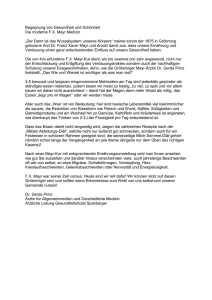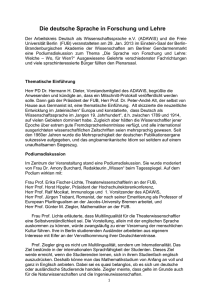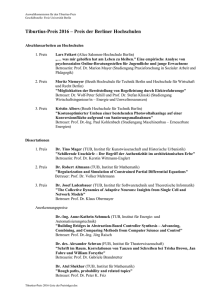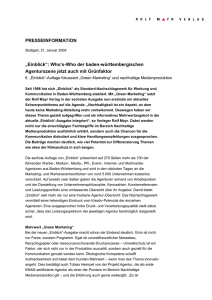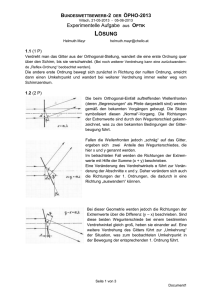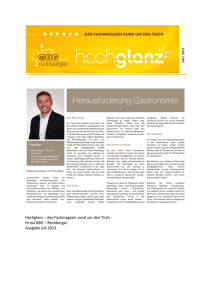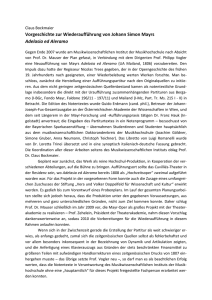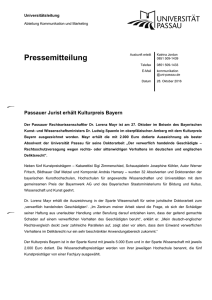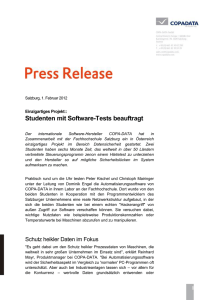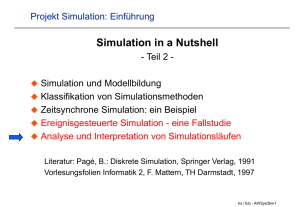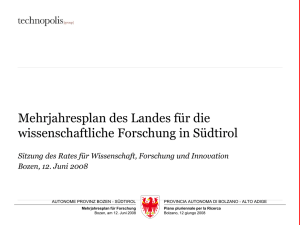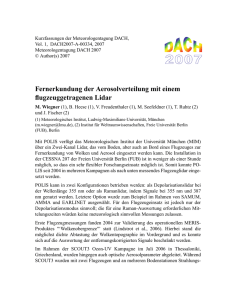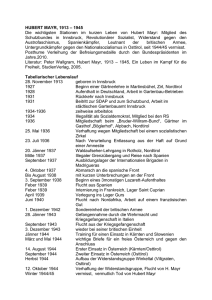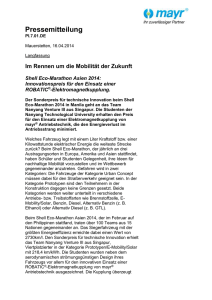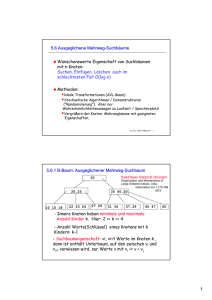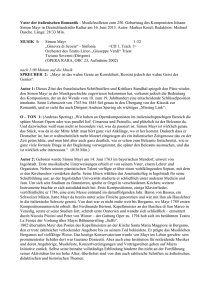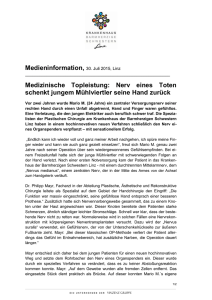Interpretation der mechanischen und thermischen Eigenschaften
Werbung
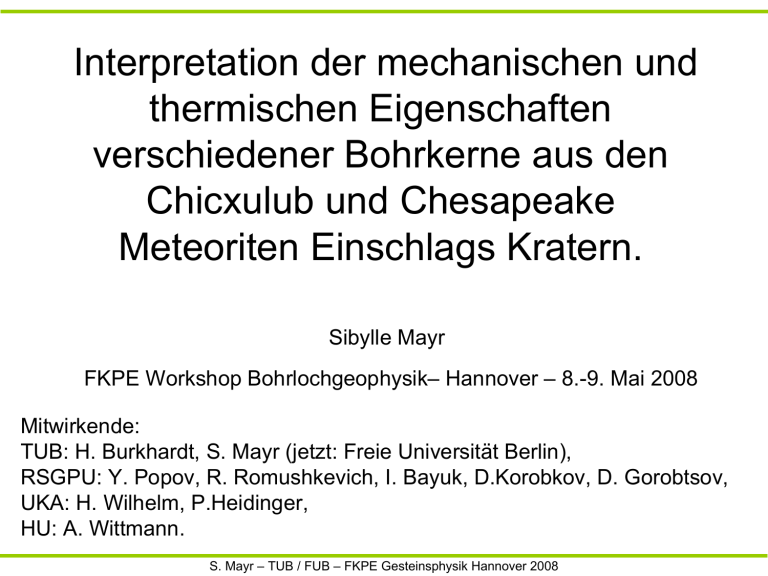
Interpretation der mechanischen und thermischen Eigenschaften verschiedener Bohrkerne aus den Chicxulub und Chesapeake Meteoriten Einschlags Kratern. Sibylle Mayr FKPE Workshop Bohrlochgeophysik– Hannover – 8.-9. Mai 2008 Mitwirkende: TUB: H. Burkhardt, S. Mayr (jetzt: Freie Universität Berlin), RSGPU: Y. Popov, R. Romushkevich, I. Bayuk, D.Korobkov, D. Gorobtsov, UKA: H. Wilhelm, P.Heidinger, HU: A. Wittmann. S. Mayr – TUB / FUB – FKPE Gesteinsphysik Hannover 2008 Inhalt • Motivation • Methoden • Impakt Strukturen – Chicxulub, Yukatan, Mexico, K-T-Grenze (65 Ma) – Chesapeake, Virginia, USA, late Eocene (35.7 Ma) • Schlussfolgerungen S. Mayr – TUB / FUB – FKPE Gesteinsphysik Hannover 2008 Motivation für Interpretation geophysikalischer Feldmessungen zusätzlich zu Bohrlochmessungen, Temperatur etc. z.B. für Berechnung der Wärmestromdichte (H.Wilhelm, P.Heidinger, Y.Popov) als Hintergundinformation für die lithologische Interpretation für die weitere petrophysikalische Charakterisierung der Impakt Gesteine Æ eng beprobter Bohrkern! Æ Porosität, Dichte Æ thermische und elastische Eigenschaften Russian State Geological Prospecting University S. Mayr – TUB / FUB – FKPE Gesteinsphysik Hannover 2008 Optical Scanning Instruments for Thermal Conductivity Measurements (RSGPU) Russian State Geological Prospecting University λ , W/(m*K) Thermal Conductivitypar Anisotropy Studying 1.35 1.3 Standards 1.25 1.2 1.15 1.1 Cores 1.05 1 Scanning lines for anisotropy studying Optical Head S. Mayr – TUB / FUB – FKPE Gesteinsphysik Hannover 2008 Measurements on standard cores Messzelle für vp und vs Ultraschallwellen-geschwindigkeit S. Mayr – TUB / FUB – FKPE Gesteinsphysik Hannover 2008 22°30’ Alcaran Reef es lin Mexico, Yukatan S RP BI Chicxulub 22° Line A K-T-Grenze (65 Ma) 2 Corehole Yaxcopoil-1 (YAX-1) 2002 Q= X PEME lines Quarternary 1 X S1 C1 Tu Merida 21° rin g Y5A Ce no te Y6 To=Oligocene U2 Te Q Tu T1 Tu= U5 upper Tertiary Y2 U7 U6 20° Te=Eocene Ti cu lf au lt Y1 Tpal= Paleocene 19°30’ 90°30’ 90° S. Mayr – TUB / FUB – FKPE Gesteinsphysik Hannover 2008 89° 88° Chicxulub YAX-1 1511 m, 451 Proben 794.63- 807.75m Reworked suevite. 807.75- 894.94m Suevite, polymictic, allogenic clast melt breccia. Below 894.94 m carbonates with monomictic cataclastic breccia and breccia dike . Mayr et al., J. Geophys. Res., doi:10.1029/2007JB005420, in press Mayr et al., Int J Earth Sci (Geol Rundsch), doi: 10.1007/s00531-0070227-6, in press S. Mayr – TUB / FUB – FKPE Gesteinsphysik Hannover 2008 Correlation of physical properties S. Mayr – TUB / FUB – FKPE Gesteinsphysik Hannover 2008 S. Mayr – TUB / FUB – FKPE Gesteinsphysik Hannover 2008 Correlation of physical properties for calculation of „LOGS“ S. Mayr – TUB / FUB – FKPE Gesteinsphysik Hannover 2008 Yax-1 TC, Φ, ρsat S. Mayr – TUB / FUB – FKPE Gesteinsphysik Hannover 2008 Post-impact and suevitic breccia Φ, ρ sat, vp sat, TC, 1 cm 1 cm YAX-1_886.86m S. Mayr – TUB / FUB – FKPE Gesteinsphysik Hannover 2008 Post-impact and suevitic breccia Φ, ρ sat, vp sat, TC, ΔT/Δz, gamma, β, S. Mayr – TUB / FUB – FKPE Gesteinsphysik Hannover 2008 k Pre-impact: Calcarenite, Anhydrite, Dolomite Φ, ρsolid, vp sat, TC, ΔT/Δz, gamma, β , S. Mayr – TUB / FUB – FKPE Gesteinsphysik Hannover 2008 k Velocities pre-impact rocks Pre-impact dolomite with lens or streak of anhydrite YAX-1_1207.03m Visible fractures - > reduced velocity and increased porosity Fractured pre-impact dolomite autoclastic breccia YAX-1_1387.05m S. Mayr – TUB / FUB – FKPE Gesteinsphysik Hannover 2008 Chesapeake struktur (Virginia, USA) Corehole Eyreville – late Eocene (35.7 Ma) 2005 Adapted from Gohn et al. (2006, EOS) S. Mayr – TUB / FUB – FKPE Gesteinsphysik Hannover 2008 Chesapeake 1765 m, clay Clay, silty clay, oxidized clay 480 Proben 444m – 1096m Exmore Sediment Diamicton Sandstone 1393m – ca. 1555m Mayr et al., GSA-Special Paper, doi:10.1130/2009.2458(07) S. Mayr – TUB / FUB – FKPE Gesteinsphysik Hannover 2008 Correlation of physical properties (dry rocks) Granite, Suevite, Basement Granite, Suevite, Basement Clay and sandstone S. Mayr – TUB / FUB – FKPE Gesteinsphysik Hannover 2008 Clay and sandstone Correlation of physical properties (dry rocks) Granite, Suevite, Basement S. Mayr – TUB / FUB – FKPE Gesteinsphysik Hannover 2008 Lithology, USGS All S. Mayr – TUB / FUB – FKPE Gesteinsphysik Hannover 2008 Lithology, USGS ρ >1 All ρ <1 ρ >1 Unterschiede der Struktur: Silifizierte Schalen (Diatomene) S. Mayr – TUB / FUB – FKPE Gesteinsphysik Hannover 2008 Lithology, USGS All layering Breccia Exmore sediment breccia, Megablocks Kleine Änderungen der Porosität, der Korn-kontake der mineralogischen Zusammensetzung S. Mayr – TUB / FUB – FKPE Gesteinsphysik Hannover 2008 Exmore Breccia, Exmore Megablocks diamicton Temperature measurements with high temperatureand depth-resolution 95071 95071 10257 alcrenit* 10257 nhydrite 1205 dol itebrca*lo-nhyd m 275130* c alcrenit* 1350742 ] epth[m D c clm a 10257 10257 1205 127530 1350742 14507 sticdke,la 14507 234 /1 parst[W λ )](P *K m 6 0.1235 orsityΦ ρ tx[g/c]0 m 2.4683ρ ] epth[m D High resolution temperature measurements can be used for lithological interpretation S. Mayr – TUB / FUB – FKPE Gesteinsphysik Hannover 2008 sandstone clay Edwards et al. All Lithology, USGS Granite: high density, lowconductivity porosity (<1%) Top: variations in thermal and gamma high thermal conductivity, Bottom: small variations in TC, gamma, higherand influence of fluid on TC and vp low thermal anisotropy inhomogeneity Corresponding differentvelocity ages of granites ! high toseismic S. Mayr – TUB / FUB – FKPE Gesteinsphysik Hannover 2008 All Lithology, USGS Suevite and lithic breccia, Schist and pegmatite, minor lithic breccia: Heterogeneous in borehole and core scale, S. Mayr – TUB / FUB – FKPE Gesteinsphysik Hannover 2008 Lithology, USGS Suevite changes in mineralogical Pegmatite, cataclastic composition and structure -> fractures! Schist, cataclastic Pegmatite Schist S. Mayr – TUB / FUB – FKPE Gesteinsphysik Hannover 2008 Schlußfolgerungen ¾ Labor-Messungen an dicht gesampelten Proben: detaillierte Informationen für die Interpretation geophysikalischer Felddaten. ¾ Temperatur nutzbar für die lithologische Interpretation. Suevite: ¾ Inhomogen auf Proben und Bohrloch Skala aufgrund der Unterschiede in der mineralogischen Zusammensetzung, Porosität und der Mikrostruktur. Gesteine unterhalb der Suevite: ¾ Einfluß der Lithologie und der geologischen “pre- impact” Geschichte ¾ Vergleich mit ähnlichen Gesteinen von ausserhalb der Impakt Struktur wäre zur besseren Interpretation notwendig! S. Mayr – TUB / FUB – FKPE Gesteinsphysik Hannover 2008 Danke für Ihre Aufmerksamkeit Dank auch an G. Gohn, W. Horton, L. Edwards (USGS), allen die bei der Probenvorbereitung in Mexiko und USA beteiligt waren, sowie an den Labormessungen Moskau Berlin Beteiligten. S. Mayr – TUB / FUB –in FKPE Gesteinsphysikund Hannover 2008

